Work Lights Market Research, 2032
The global work lights market size was valued at $32.4 billion in 2022, and work lights industry is projected to reach $48.7 billion by 2032, growing at a CAGR of 4.2% from 2023 to 2032.
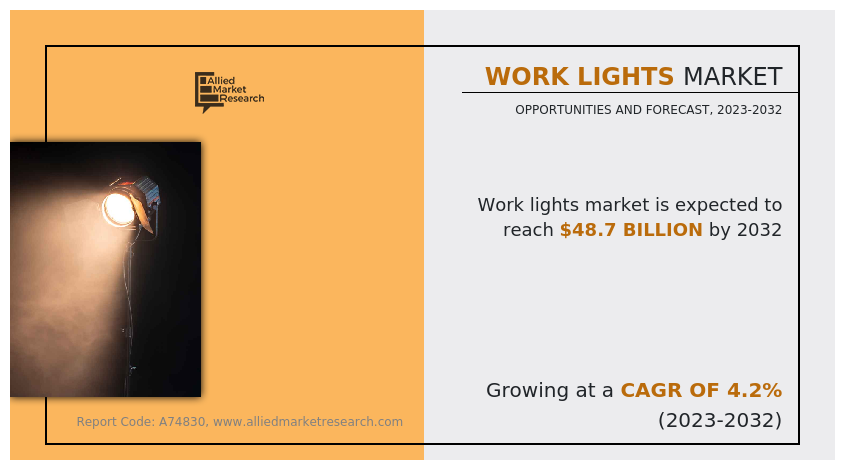
Work lights are specialized lighting fixtures or devices used to illuminate workspaces, job sites, or specific tasks that require additional lighting. These lights are typically designed to provide bright, focused, and adjustable illumination to enhance visibility, improve safety, and optimize productivity in different working conditions. Work lights are commonly used in industries such as construction, manufacturing, automotive, mining, maintenance, and emergency services, where proper lighting is essential for efficient operations.
The work lights market encompasses a wide range of products, including portable work lights, task lights, handheld lights, floodlights, spotlights, light towers, and other lighting solutions tailored to specific applications. These lights may use various technologies, such as LED (Light Emitting Diode), halogen, fluorescent, or incandescent bulbs, with LED lighting being increasingly popular due to its energy efficiency and durability.
The surge in industrial growth, particularly in sectors such as construction, manufacturing, and maintenance, has propelled the demand for reliable lighting solutions. These industries require enhanced visibility, safety, and productivity, and work lights fulfill these requirements effectively. The rapid expansion of industrial activities worldwide, coupled with urbanization, infrastructure development, and increased investments in the industrial sector, has further fueled the demand for work lights.
Stringent safety regulations in industrial workplaces have also played a vital role in driving market growth, as proper lighting systems are mandated to ensure worker safety. Technological advancements, especially in LED lighting, have contributed to the market's expansion by offering energy-efficient and long-lasting lighting solutions. Moreover, the rise in outdoor activities and events globally has created another significant market opportunity for work lights. Outdoor recreational pursuits, such as camping, hiking, sports events, and festivals, require portable lighting solutions for illumination and safety during nighttime or low-light conditions. Work lights cater to these needs with their compact size, adjustable brightness, and durability, making them suitable for various outdoor applications. They are also used in event management, construction, and infrastructure setup during outdoor festivals and sporting events.
Additionally, the growing automotive industry has been a crucial driver of the work lights market. Work lights are extensively utilized in automotive manufacturing, repair shops, and vehicle inspections, providing essential lighting solutions for professionals. The increasing vehicle production, sales, and aftermarket services have contributed to the rising demand for work lights in the automotive sector. Stringent safety and quality regulations in the industry have further boosted the market by mandating proper lighting systems in manufacturing and repair processes.
The emergence of electric vehicles (EVs) and autonomous vehicles (AVs) has also created opportunities for specialized work lights in charging stations, maintenance, and testing purposes. As the automotive industry continues to evolve, the demand for work lights is expected to remain robust. However, the work lights market is highly competitive, with numerous manufacturers vying for market share. This intense competition leads to price wars, reduced profit margins, and difficulties in differentiating products.
To overcome these challenges, companies must focus on cost optimization, efficient production processes, and innovation to offer unique features and value propositions. Building a strong brand reputation, establishing distribution networks, and providing excellent customer service are also essential strategies to thrive in a competitive market. Moreover, the availability of substitutes poses another barrier to the work lights market growth.
Traditional lighting solutions such as incandescent bulbs and fluorescent lights still find use in certain applications due to familiarity and lower upfront costs. Manufacturers need to highlight the benefits of work lights, such as energy efficiency, longevity, and superior performance, and educate customers about the advantages they offer. Innovation and product differentiation can also help capture market share by providing features that traditional lighting solutions lack.
Furthermore, the increasing focus on energy efficiency and sustainability presents opportunities for work light manufacturers. Developing and marketing energy-efficient work lights that align with green practices and regulations can tap into a growing demand for sustainable lighting solutions. Finally, emerging markets offer significant opportunities due to rapid industrialization, infrastructure development, and urbanization. Manufacturers can seize these opportunities by customizing products, expanding distribution networks, and understanding local regulations and preferences.
"Illuminating Innovations: Trends and Developments in the Work Lights Market"
In the fast-paced world of work lights, innovation is constantly driving trends and developments in the market. The need for efficient and reliable lighting solutions has led to the emergence of groundbreaking technologies and cutting-edge designs. One notable trend is the increasing adoption of LED (Light-Emitting Diode) technology in work lights. LED lights offer exceptional energy efficiency, long lifespan, and bright illumination, making them a popular choice among professionals in various industries.
Additionally, smart features have been incorporated into work lights, allowing for remote control, adjustable brightness levels, and even color temperature customization to suit specific working conditions. Moreover, advancements in battery technology have resulted in more powerful and long-lasting work lights, enabling users to work for extended periods without interruptions. Furthermore, there is a growing focus on ergonomic designs and portability, making work lights easier to handle and maneuver in various work environments. As the work lights market continues to evolve, these innovative trends and developments are paving the way for enhanced productivity, improved safety, and greater convenience for professionals across different sectors.
The work lights market forecast is segmented into type, light technology, power source, end-use, and region. On the basis of type, the global work lights market is segregated into portable, tripod, and handheld and retractable. As per light technology, it is divided into integrated LED, halogen, and fluorescent. According to power source, it is bifurcated into plug-in and battery. Depending on end-use, the market is segregated into construction, warehouses, manufacturing, mining, and others. Region wise, the market is studied across North America, Europe, Asia-Pacific, and LAMEA and suggests future growth opportunities.
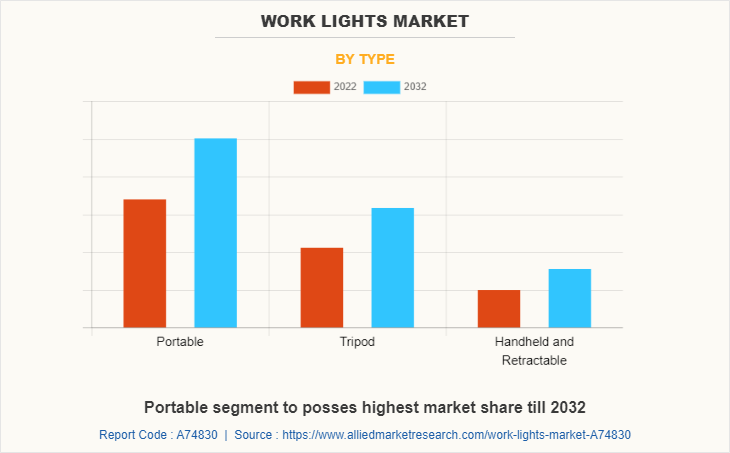
On the basis of type, the portable segment emerged as the global leader by acquiring more than half of the work lights market share in 2022 and is anticipated to continue this trend during the forecast period. There is a rising demand for these lights across industries such as construction, manufacturing, and emergency services, driven by their flexibility and ease of use. The advent of LED technology has been a game-changer, providing energy efficiency, durability, and enhanced brightness. Energy efficiency is a significant focus, and LED-based portable work lights consume less power, reducing costs and promoting sustainability.
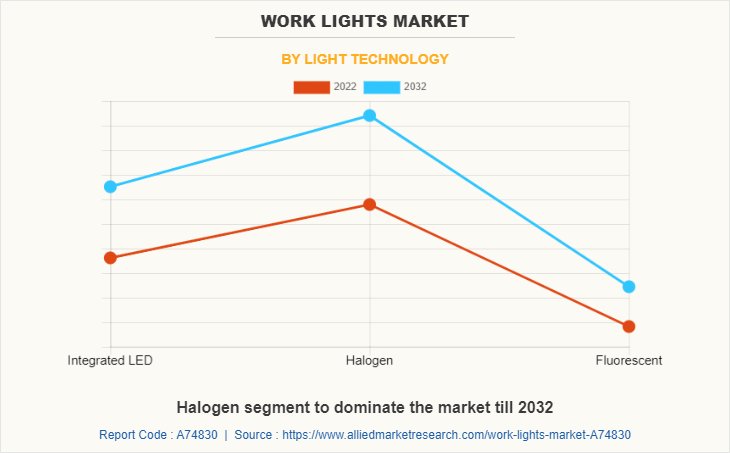
As per light technology, the halogen segment accounted for nearly half of the global market share in 2022. Halogen technology remains a prominent player in the work lights market due to its durability, reliability, and cost-effectiveness. With their ability to withstand harsh conditions and provide instant illumination, halogen lights are favored in work environments that require robust lighting solutions. Their affordability and longer lifespan compared to incandescent lights make them an attractive choice for cost-conscious consumers.
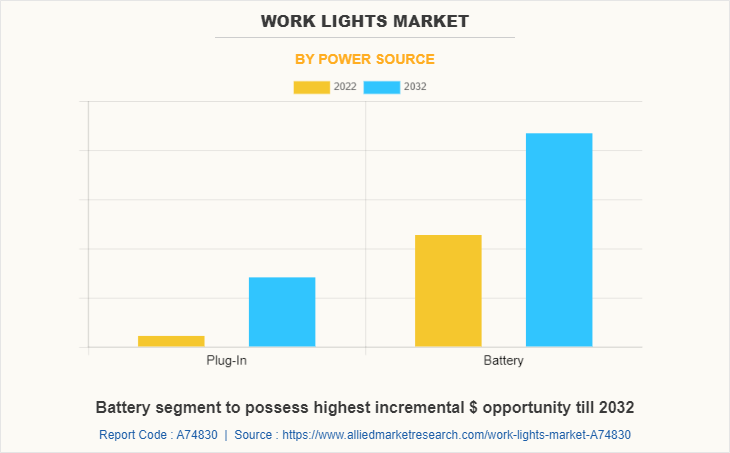
According to power source, the battery segment accounted for four-fifths of the global market share in 2022. The market for battery-powered work lights is witnessing substantial growth and opportunities driven by several key factors. The increasing demand for portable lighting solutions across industries such as construction, automotive, and emergency services has fueled the popularity of battery-powered work lights.
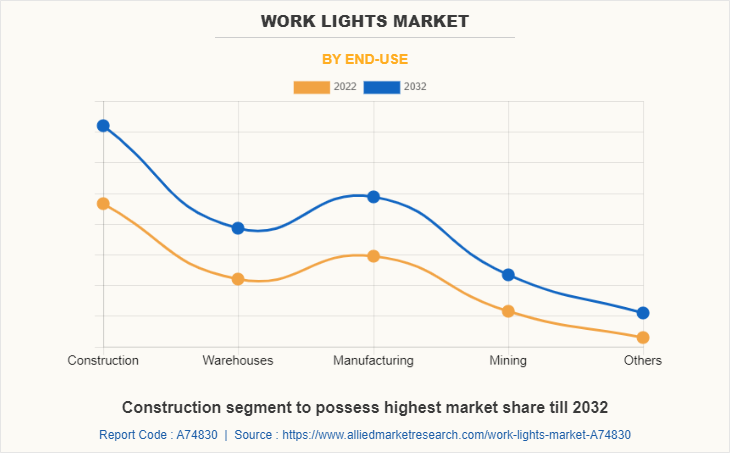
Depending on end-use, the construction segment emerged as the largest market share in 2022 which accounts for more than one-third of the work lights market share and is anticipated to continue this trend during the forecast period. The increasing construction activities worldwide drive the demand for work lights, ensuring visibility and safety on construction sites. Safety regulations and compliance requirements are also shaping the market, pushing for work lights with improved safety features. The industry is witnessing a shift toward wireless and portable solutions, providing flexibility and ease of installation.

Region wise, Asia-Pacific is the major consumer of work lights among other regions. It accounted for more than one-third of the global market share in 2022. Economic development and industrialization in this region contribute to increased demand for work lights, particularly in sectors like construction, manufacturing, and mining. The government’s focus on infrastructure projects, such as building roads, bridges, airports, and smart cities, drives the demand for work lights in construction and related activities.
Impact of Russia-Ukraine War on Global Work Lights Market
The ongoing Russia-Ukraine war has had a significant impact on the global work lights market. As Ukraine is a major manufacturer and exporter of work lights, the conflict has disrupted production and supply chains, leading to a scarcity of these products in the global market. The war has resulted in infrastructure damage, power outages, and logistical challenges, further hampering manufacturing and distribution processes.
With Ukraine being a key player in the work lights industry, the decrease in its production capacity has created a supply-demand gap, driving up prices and causing delays in fulfilling orders worldwide. As a result, businesses and industries relying on work lights for construction, maintenance, and other operations have faced difficulties in acquiring the necessary equipment, leading to project delays and cost escalations.
In response to the uncertain situation, buyers have sought alternative suppliers, but the transition has not been seamless, as finding manufacturers with similar production capabilities and quality standards has proven challenging. This disruption in the global work lights market highlights the vulnerability of industries dependent on geopolitical stability and underscores the need for diversification of supply chains to mitigate such risks in the future.
Competitive Landscape
Steisone (STE), AIS LED, Scangrip North America Inc., KIRA Leuchten GmbH, Hugo Brennenstuhl GmbH & Co Kommanditgesellschaft, LEDlenser, Gentos Co., Ltd., Horpol J.I.A.T. Horeczy SP. K., Peterson Manufacturing, and Luxgend Electronics Co., Ltd. are some of the major players discussed in the report.
Key Benefits For Stakeholders
- This report provides a quantitative analysis of the market segments, current trends, estimations, and dynamics of the work lights market analysis from 2022 to 2032 to identify the prevailing work lights market opportunities.
- The market research is offered along with information related to key drivers, restraints, and opportunities.
- Porter's five forces analysis highlights the potency of buyers and suppliers to enable stakeholders make profit-oriented business decisions and strengthen their supplier-buyer network.
- In-depth analysis of the work lights market segmentation assists to determine the prevailing market opportunities.
- Major countries in each region are mapped according to their revenue contribution to the global market.
- Market player positioning facilitates benchmarking and provides a clear understanding of the present position of the market players.
- The report includes the analysis of the regional as well as global work lights market trends, key players, market segments, application areas, and market growth strategies.
Work Lights Market Report Highlights
| Aspects | Details |
| Market Size By 2032 | USD 48.7 billion |
| Growth Rate | CAGR of 4.2% |
| Forecast period | 2022 - 2032 |
| Report Pages | 308 |
| By Type |
|
| By Light Technology |
|
| By Power Source |
|
| By End-Use |
|
| By Region |
|
| Key Market Players | LEDLENSER, AIS LED, Luxgend Electronics Co., Ltd., KIRA Leuchten GmbH, Scangrip North America Inc., STE, Peterson Manufacturing, Horpol J.I.A.T. Horeczy SP. K., Hugo Brennenstuhl GmbH & Co Kommanditgesellschaft, Gentos Co., Ltd. |
Analyst Review
According to CXO’s perspective, the work lights market is expected to witness significant growth in the coming years. This growth can be attributed to various factors, including the increasing demand for efficient and durable lighting solutions in the industrial and commercial sectors. CXOs believe that the work lights market will gain high traction due to the growing awareness among individuals and businesses regarding the importance of high-quality lighting in workplaces. Efficient work lights not only enhance visibility and productivity but also contribute to employee safety and well-being.
The market for work lights is poised for rapid growth during the forecast period, primarily driven by the rise in demand from industries such as construction, manufacturing, automotive, and mining. These sectors require reliable lighting solutions that can withstand harsh working conditions and provide sufficient illumination for various tasks. Government initiatives aimed at improving workplace safety regulations and guidelines also play a crucial role in driving the adoption of work lights. Stringent regulations and standards regarding lighting in hazardous environments create a favorable market growth environment.
CXOs emphasize that major market players have responded to the increasing demand by introducing advanced work lights that prioritize energy efficiency, durability, and ergonomic designs. These lights are designed to meet the specific requirements of different industries and provide long-lasting performance even in demanding environments. In terms of geographical opportunities, the work lights market holds promising prospects in regions such as North America, Europe, and Asia-Pacific. The industrialization and infrastructure development in these regions and the growing focus on occupational safety are expected to drive the demand for work lights.
However, CXOs highlighted that the high initial cost associated with premium work lights remains a significant barrier to market growth. Cost-conscious customers may hesitate to invest in advanced lighting solutions, especially in price-sensitive markets. Therefore, market players need to focus on offering competitive pricing strategies and cost-effective solutions to overcome this challenge.
Surge in industrial growth and Increase in outdoor activities and events are the key factors boosting the Work lights market growth.
The market value of Work lights in 2032 is expected to be $48.7 billion
Steisone (STE), AIS LED, Scangrip North America Inc., KIRA Leuchten GmbH, Hugo Brennenstuhl GmbH & Co Kommanditgesellschaft, LEDlenser, Gentos Co., Ltd., Horpol J.I.A.T. Horeczy SP. K., Peterson Manufacturing, and Luxgend Electronics Co., Ltd.
Construction application is projected to increase the demand for Work lights Market
The work lights market is segmented into type, light technology, power source, end-use, and region. On the basis of type, the global work lights market is segregated into portable, tripod, and handheld and retractable. As per light technology, it is divided into integrated LED, halogen, and fluorescent. According to power source, the market is bifurcated into plug-in and battery. Depending on end-use, the market is segregated into construction, warehouses, manufacturing, mining, and others. Region wise, the market is studied across North America, Europe, Asia-Pacific, and LAMEA.
Developments in automotive industry is the Main Driver of Work lights Market.
Loading Table Of Content...
Loading Research Methodology...


